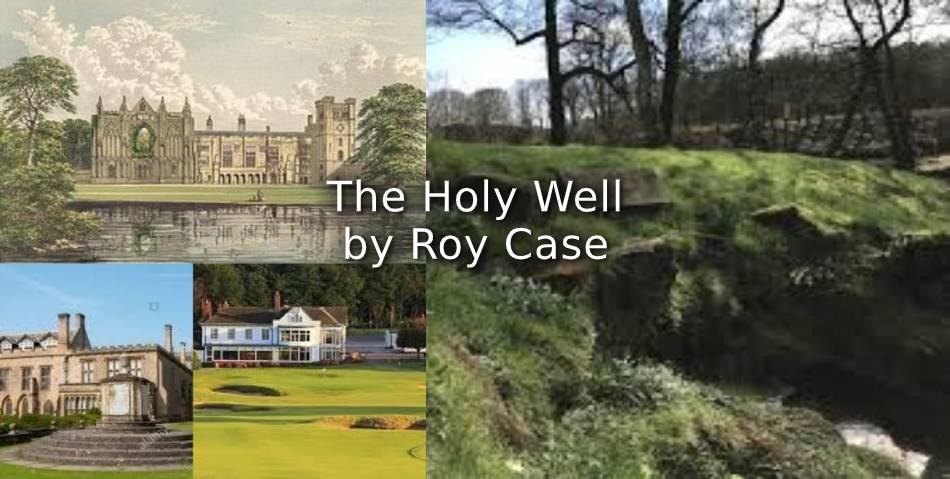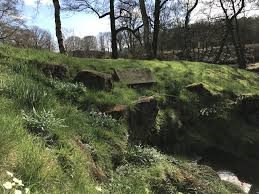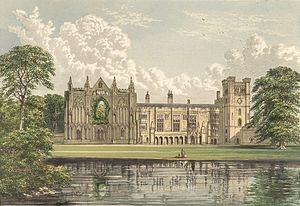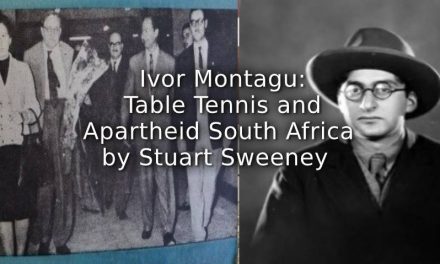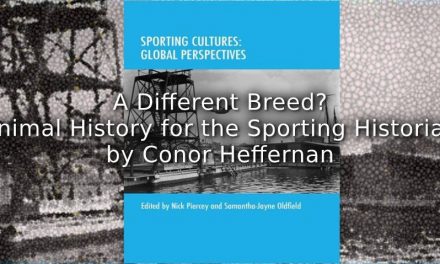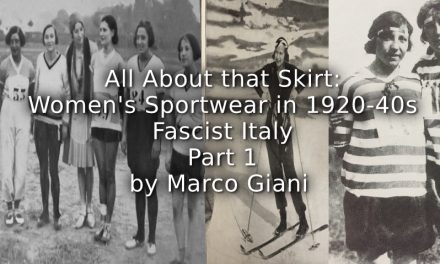Golfers looking for a minor miracle may find deliverance through a scoop of water served from the ‘Holy Well’, which can be found immediately to the right of the 8th tee at the Notts. Golf Club in Kirkby-in-Ashfield, or Hollinwell, as the course is known colloquially. It is said the spring, inherited its saintly name since the monks from the nearby 12th century Newstead Priory used to collect their water from it. And to this day golfers may still quench their thirst and enjoy a taste of the extremely pure water which retains a constant temperature throughout the year.
- Notts. Golf Club
- The ‘Holy Well’
The Notts Golf Club, home to one of England’s most outstanding golf courses, was founded in 1887, on common ground on the outskirts of the city of Nottingham, which it shared with two other clubs. When the Nottinghamshire Council threatened to convert the land into a cemetery, its members decided to seek a new home, and in 1899 came across a large area of heath land 14 miles north of the city in Kirkby Forest. Its undulating sandy soil was ideal for golf, and the Scottish professional golfer Willie Park Junior [1864-1925] was commissioned to design a layout, with the provision, stipulated by the Ecclesiastical Commissioners, that it could not be used for golf on Sundays. The course opened in 1901, and was later modified, to include bunkers and lengthened in preparation for the rubber-cored ball, by the golf course architect, J.H.Taylor [1871-1963], one of the pioneers of the modern game of golf, and the club professional and head green keeper, Tom Williamson [1880-1950], who served the club for more than half-a-century,
Early in your round, on your way to the ‘Holy Well’, you will come across a rocky outcrop behind the second green, which is known as ‘Robin Hood’s Seat’. Where it is said the legendary outlaw would sit and watch the road below, waiting for suitable victims to pass by. Towards the end of your round, at the rear of the relatively short dog-leg par four 16th green, lies a large stone which some members describe as ‘Maid Marian’s Bed’.
The story of the legendary Holy Well began in the 12th century when the priory of St. Mary of Newstead was founded around 1170 by King Henry II [1133-1189], the first King of the House of Plantagenet, in reparation of one of the many penances he is said to have paid following the murder of the Archbishop of Canterbury, the venerable Thomas a Becket [1118-1170]. However, contrary to its current name, Newstead was never an abbey, it was originally an Augustinian priory for a group of black-robed monks, known as the ‘Black Canons’, said to be the inspiration for Friar Tuck in the tales of Robin Hood…
The enforced Dissolution of the Monasteries [1536-1541] was one of the most radical events in English history. The English lawyer and statesman, Thomas Cromwell [circa 1485- 1540] the 1st Earl of Essex, KG, PC, served as Chief Minister for Henry VIII [1491-1547] until his execution on the orders of the King. During his term in office Cromwell created the series of administrative and legal processes for the Dissolution, including the Parliamentary Act of Supremacy [1534] which defined the reigning monarch as Supreme Head of the Church, severing England from its ecclesiastical links with Rome.
- Newstead Abbey [circa 1880]
- Thomas Cromwell, 1st Earl of Essex
With one adult male in every fifty in religious orders, Henry disbanded all the monasteries, priories, convents and friaries in England, Wales and Ireland, disposing of their assets to increase the income of the Crown and fund his military campaigns. Newstead Priory was surrendered to King Henry VIII in 1540, who later gave it over to Sir John Byron [1599-1652] of Colwick, who converted it into a private country house, launching the Byron families association with the estate which endured for over two centuries.
Rumour has it Sir John’s actions resulted in a curse placed upon those who lived in his birthplace of Newstead village. A ‘Goblin Friar’ was said to appear to the head of the Byron family scowling angrily at happy events, and gleefully grinning before any sorrowful happening, especially when a member of the Byron family died.
The 13th century ecclesiastical buildings were largely ruined during the dissolution of the monasteries, and many additions have subsequently bben made to the original buildings. Early in the 18th century the gardens were extensively landscaped by William, the 4th Lord Byron [1695-1736], who amassed a hugely admired collection of artistic masterpieces.
The 5th Baron William Byron [1722-1798], and great uncle of the literary Lord Byron, was a politician who in 1765 became known as the ‘Wicked Lord’ after killing his cousin, a neighbouring landowner, in a duel. He was tried for murder before his peers in the House of Lords, but was convicted of manslaughter, which at the time was considered so insignificant that he was only required to pay a small fine and was released and returned to Newstead, where he lived until his death. During his tenure the Abbey suffered a severe downturn in fortune. William lavished money on the estate, building Gothic follies, staging mock navy battles on the lake, and taking out loans to pursue his pleasure of horse-racing and gambling. Though-out the late 18th century he ruined the estate, felling trees, killing off deer, and stripping the Abbey and estate of its artistic treasures and furniture, to raise cash to pay off his debts. But it was not enough and there was no hope of restoring the Abbey to its former glory.
The title and Newstead Abbey then passed to his great-nephew, the famous and notorious poet., George Gordon Byron, who became the 6th Baron Byron [1788-1824] at the tender age of 10. When the young Lord Byron inherited Newstead he was greatly impressed by the estate, although the scale of the problems presented were enormous. Essential repairs were imperative, and yet the Abbey’s annual income had fallen to around £800. Consequently, in 1803 the Abbey and park was leased for five years, for the sum of £50 a year, to 23 year-old Henry Edward Yelverton [1780-1810], the 19th Baron Grey de Ruthyn. And Byron and his mother moved to the nearby town of Southwell until in 1808 he returned to Newstead and began extensive and expensive renovations.
Byron’s had a much loved Newfoundland dog named Boatswain, which died and was and buried at Newstead Abbey. Where an impressive monument now stands, inscribed with one of Byron’s best-known poems ‘Epitaph to a Dog’.
- Boatswain’s Memorial Monument
Near this Spot
are deposited the Remains of one
who possessed Beauty without Vanity,
Strength without Insolence,
Courage without Ferosity,
and all the virtues of Man without his Vices.
This praise, which would be unmeaning Flattery
if inscribed over human Ashes,
is but a just tribute to the Memory of
Boatswain, a Dog
who was born in Newfoundland May 1803
and died at Newstead November 18th 1808.
Byron is said to have pledged, ‘Newstead and I stand or fall together’. But without adequate financial means, in a final attempt to resolve the crippling fiscal issues, he endured a disastrous marriage to the heiress Anne Milbanke [1792-1860]. Shortly before which, the 6th Lord Byron is said to have encountered the ‘Goblin Friar’. When asleep in his Newstead bedroom, the poet was woken by the sensation of something mounting the bed. On sitting up he was confronted by the apparition of a black shapeless mass, with red glowing eyes, which rolled from the bed onto the floor and disappeared.
The Byron family occupancy of Newstead came to an end following the death of the eminent poet in Missolonghi in western Greece. Although Byron had wanted to be buried with Boatswain, his body now lies in the peaceful church dedicated to St. Mary Magdelene at Hucknall Torkard, on the site of a medieval Saxon church built in the 12th century a few miles from Newstead.
In addition to the ‘Goblin Friar’, the ancestral home of the Byron family provides the setting for a collection of ghosts and ghoulish stories.
The Black Friar:
There are many stories about appearances of the Black Friar. In the 1930s the wife of a resident of Newstead village was due to give birth, and her husband telephoned the doctor to attend her as soon as possible. However, it was some time before the doctor finally made an appearance, when the nervously anxious husband scolded the doctor, announcing that he ‘was only just in time’.
The doctor replied he would have been even later had he not stopped by a waterfall in the grounds of Newstead Abbey and asked the way from a monk that was standing there. The black-robed figure said nothing but pointed him in the right direction.
However, there had been no monks at the Abbey for several hundred years.
The Rose Lady:
At a certain spot in Newstead Abbey, a passageway crosses the bottom of a staircase, where there is often a heavy, scent of roses and lavender. Although nothing has ever been seen, there are numerous stories of people smelling the fragrant aroma.
From time to time, the Abbey staff organise ghost tours as a visitor attraction, and on such occasions re-enact some of the ghostly goings-on. Although the Rose Lady is not usually included on the schedule it is said occasionally has other ideas, and the group of visitors become aware of an extremely strong scent of roses and lavender. Convinced it is a staged effect they refuse to believe it is out of the ordinary. But the staff know otherwise !
The White Lady:
Soon after the 6th Lord Byron finally left Newstead Abbey, he sold it to an old school friend an British Army officer during the Napoleonic Wars, Thomas Wildman [1787-1859]. Shortly afterwards, Sophie Hyatt, a devoted follower of the poet’s work, came to live at a nearby farm. When the Wildman family learned how much she loved Byron’s work they thoughtfully allowed her to wander freely around the grounds whenever she wanted.
Sophie lived on revenue provided by a relative who died in 1825, consequently the money dried up. However, Sophie had another relative in America and decided she must try to make contact with them and ask for their help. Before setting off she left a written note for the Wildman’s to let them know what she was doing. But when Mrs Wildman read the note she immediately dispatched a rider to intercept Sophie and offer her accommodation in the grounds of Newstead for the rest of her life.
The horse and rider set off in hot pursuit and upon reaching the Market Square in Nottingham, came across a large crowd of people gathered around a horse and cart outside the Black Boy public house. The rider dismounted and pushed through the people to find Sophie lying dead on the ground. Sophie had failed to hear the drayman’s warning cry and was had been run over by his cart.
Sophie Hyatt can still be seen wandering through her beloved gardens at Newstead Abbey, especially along one particular path now known as the ‘White Lady’s Walk’.
The Rooks:
Washington Irving, the American author of the famous ghost story. ‘The Legend of Sleepy Hollow’, once stayed at Newstead in the 1800s. During his stay he noticed that every morning the rooks would fly off and sweep the countryside for food, returning in the evening when their crowing discussion of the day’s events would echo around the estate.
Irving was informed the rooks observed the Sabbath Day, and would set out every day except on Sunday, when they remained in the Abbey grounds. At first Irving didn’t believe it until he saw for himself the rooks devoted Sunday to their nearest and dearest, and never left the estate.
Local tradition has it the rooks at Newstead are the souls of the ‘Black Monks’, reborn as birds to occupy their old priory. So strong was this belief that, contrary to common country practice, the Newstead rooks were left unhindered and never shot.
In the late 18th century, when dredging the fishpond lake at the Abbey, a lectern was discovered which had been thrown there by the monks, to save it from discovery during the Dissolution of the Monasteries. In 1805 the lectern was donated to the Southwell Minster situated 15 miles east of Newstead, where it still resides.
The century following the death of the 6th Lord Byron saw many changes at Newstead, before ownership eventually passed to the businessman, philanthropist and cricket enthusiast Sir Julien Cahn [1882-1944].
Born in Cardiff, Cahn grew up in Nottingham, where his father owned a furnishing company, which Cahn expanded to include more than 300 stores. On his retirement in 1943 he sold the business to Great Universal Stores.
During the great economic depression of the 1930’s and throughout World War II, Cahn sponsored several cricket clubs in need of funding, and in 1935 paid the annual membership subscriptions for more than 800 new members to join the Nottinghamshire County Cricket Club. Cricket was Cahn’s principal sporting passion and he served as president of both the Nottinghamshire and Leicestershire County Cricket Clubs.
He was knighted in 1929 and made a baronet five years later for his charitable work and services to agriculture.
Newstead Abbey is now publicly owned by Nottingham City Council, and houses a museum containing Byron memorabilia.
Article © of Roy Case

